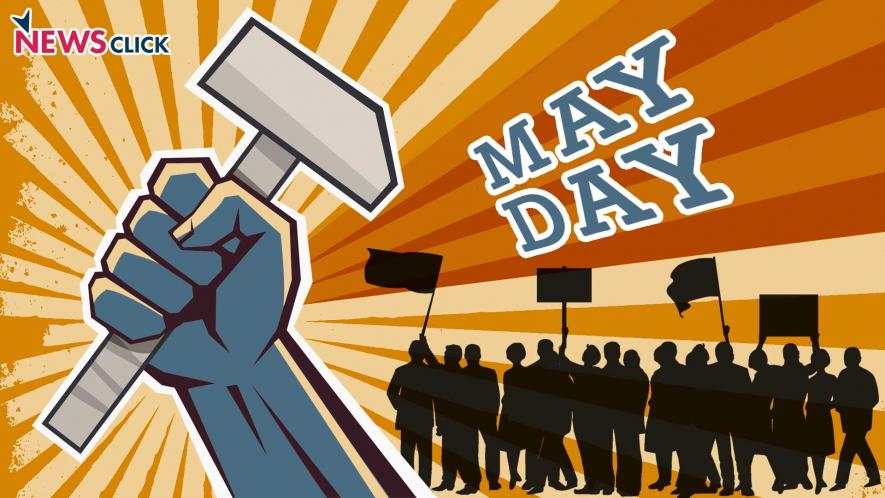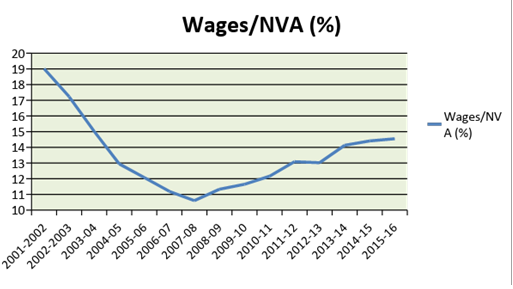India’s Working Class Prepares For Major Economic and Political Battles

After three years of almost continuous struggles and massive strike actions, May Day 2018 was observed with a massive show of strength throughout the country. What marked this year’s May Day was a growing resolve to unseat the present ruling right-wing dispensation led by Narendra Modi.
There are two reasons why India’s fragmented working class is in ferment. One is the open attack launched on its living standards – indeed, on its livelihoods – in the past four years by the capitalist class, with the sanction and help of the government. Real wages are dipping, regular jobs are being replaced by out-contracted jobs even in the public sector, labour laws are being dismantled, the public sector is being privatized, women’s employment is at an all-time low, and there is a deliberate marginalization of the workers from the national agenda.
As can be seen in the chart below, wages as a share of net value added declined sharply till 2007-08 and 2008-09, and then have risen slightly. But even in 2015-16, the ratio is about 15% compared to about 19% in 2001. The increase since 2008-09 has plateaued in the past three years. What this indicates is: value created by workers’ labour has increased at a higher rate than the wages they get in return. Data is from the government’s Annual Survey of Industries (ASI).

The features of this onslaught are brutal and chilling. There has been a dip in the labour force numbers from about 444 million in 2016 to 442 million in 2018. Unemployment is estimated at around 7% but under-employment (or masked unemployment) is estimated at about 37%. Monthly wages range from Rs.6,000 to Rs.10,000 even though calculations based on a minimum calorific intake of 2,200 kcal per day per capita for a family of two adults and two children put the minimum wage at Rs.18,000. Farmers are estimated to have lost Rs.2 billion in last year’s summer crop due to low purchase prices. Meanwhile, the government has sold off Rs.1.25 billion worth of public sector assets to private industrialists. It has started the process of diluting 44 labour laws and merging them into 4 Labour Codes that give employers the freedom to hire and fire and to fix wages. It has refused to negotiate on minimum wages or social security cover.
Broad unity
The second reason is a broad unity among various trade unions that has emerged in recent years, cutting across political or sectoral lines – and its expression as a fighting force through two countrywide strikes (in 2015 and 2016), followed by a historic mass sit-in at the capital city, New Delhi, in 2017. There have been strike struggles in various industrial sectors like coal, steel, plantation, construction, road transport, ports and docks, government employees, garments and textiles, etc. This has imbued the workers with confidence and magnified the desire to fight back the onslaught.
Another important feature of the current period is that it is not just the industrial working class that is restless and fighting back. In the agrarian sector too, there has been a precipitous decline in peasant earnings with a concomitant rise in indebtedness. This has led to mass protests in at least 13 states of India with thousands of peasants – men and women – coming out on the streets, sometimes forcing the government. to accede to their demands, at least in principle, as in the States of Maharashtra and Rajasthan.
This upsurge in peasant protests has provided synergetic impetus to the workers’ struggles because a large section of the workers have continuing roots in rural communities. Distress-driven migrants make up a large segment of workers in urban areas, having moved to urban or peri-urban centres in search of jobs, even if at the lowest rung of the informal urban economy.
Although the crisis of low incomes, lack of jobs and multiple deprivations (education, health, social security) are a feature of the socio-economic system in India right since Independence from British colonial rule over 70 years ago, the neo-liberal order imposed on the country since the early 1990s, and its naked form that has emerged under the present regime, has decisively led to an aggravation of class conflict. This sharpening contradiction is what is finding expression in wider struggles, and the resolve of May Day 2018.
But, there is another threat to the working class’ struggles in India. It is the increasing use of divisions based on religion, caste, ultra-nationalism and other identities by the ruling classes. The current right-wing regime and its stormtroopers have been openly fanning the flames of Hindu majoritarianism, spreading poisonous hatred against the Muslim minority (and others too), and instigating anti-Muslim violence. Similarly, it has unleashed a wave of violence against Dalits (formerly called the untouchable castes), who form a large share of working people in both the agrarian and industrial sectors. This is an incendiary strategy with a big potential for disrupting the unity of mass movements and diverting them into dead ends.
This May Day, the working class in India has to also prepare for a fight against this danger. In fact, it has to evolve a strategy that will fight the battles on both fronts together, for they are inextricably bound to each other.
Get the latest reports & analysis with people's perspective on Protests, movements & deep analytical videos, discussions of the current affairs in your Telegram app. Subscribe to NewsClick's Telegram channel & get Real-Time updates on stories, as they get published on our website.
























